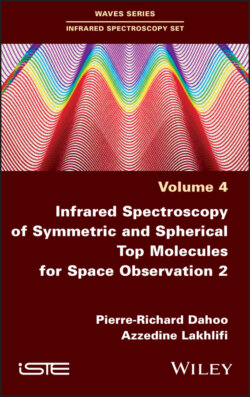Infrared Spectroscopy of Symmetric and Spherical Top Molecules for Space Observation, Volume 2

Реклама. ООО «ЛитРес», ИНН: 7719571260.
Оглавление
Pierre-Richard Dahoo. Infrared Spectroscopy of Symmetric and Spherical Top Molecules for Space Observation, Volume 2
Table of Contents
List of Illustrations
List of Tables
Guide
Pages
Infrared Spectroscopy of Symmetric and Spherical Top Molecules for Space Observation 2
Foreword
Preface
1. IR Spectra in Space Observation
1.1. Introduction
1.2. Fourier transform spectroscopy
1.2.1. Principle of IR spectrum acquisition by interferometry
1.2.2. Design and operation of a long path difference interferometer
1.2.3. FTIR absorption spectroscopy in matrices
1.2.4. LIF and DR IR–IR spectroscopies in matrices
1.3. Resonant cavity laser absorption spectroscopy
1.3.1. Intracavity laser absorption spectroscopy (ICLAS)
1.3.2. Cavity ring-down spectroscopy (CRDS)
1.3.3. Frequency comb spectroscopy (FCS)
1.4. Spectroscopy for space observation
1.4.1. Spectroscopic ellipsometry for space observation
1.4.2. Space-borne spectroscopy
1.4.3. LIDAR spectroscopy for space observation
1.5. Conclusion
1.6. Appendices. 1.6.1. Appendix 1: Measurement distortion and data processing
2. Interactions Between a Molecule and Its Solid Environment
2.1. Introduction
2.2. Active molecule – solid environment system
2.2.1. Binary interaction energy
2.2.2. Dispersion–repulsion contribution
2.2.3. Electrostatic contribution
2.2.4. Induction contribution
2.3. Two-center expansion of the term
2.4. Conclusion
2.5. Appendices. 2.5.1. Appendix 1: Multipole moments and dipole polarizability of a molecule with respect to its fixed reference frame
2.5.2. Appendix 2: Elements of the rotational matrix
2.5.3. Appendix 3: Clebsch–Gordan coefficients
3. Nanocage of Rare Gas Matrix
3.1. Introduction
3.2. Rare gases in solid state
3.3. Molecule inclusion and deformation of the doped crystal. 3.3.1. Molecule inclusion
3.3.2. Deformation of the doped crystal
3.3.3. NH3 in an argon matrix
3.3.4. Renormalization of the system’s Hamiltonian
3.4. Motions of NH3 trapped in an argon matrix
3.4.1. Vibration–inversion modeν2
3.4.2. Orientational motion
3.4.3. Translational motion
3.4.4. Orientational motion–heat bath coupling
3.5. Infrared spectra. 3.5.1. Infrared absorption coefficient
3.5.2. Bar spectrum
3.5.2.1. Far-infrared (FIR) spectrum
3.5.2.2. Near-infrared (NIR) spectrum
3.5.3. Spectral profile
3.5.3.1. Far-infrared spectral profile
3.5.3.2. Near-infrared spectral profile
3.6. Appendices. 3.6.1. Appendix 1: Normal modes of vibrations of a Bravais lattice with face centered cubic (fcc) symmetry
3.6.2. Appendix 2: Adjustment of the weakly perturbed rotational potential energy on the basis of the rotation matrix elements
3.6.3. Appendix 3: Expansion coefficients of the coupling between the orientation of the molecule and lattice vibrations (phonons)
4. Nanocages of Hydrate Clathrates
4.1. Introduction
4.2. The extended substitution model
4.3. Clathrate structures
4.4. Inclusion of a CH4 or NH3 molecule in a clathrate nanocage. 4.4.1. Inclusion model
4.4.2. Interaction potential energy – equilibrium configuration
4.5. System Hamiltonian and separation of movements
4.6. Translational motion
4.6.1. CH4 – nanocages of the sI structure. 4.6.1.1. CH4–sI–small cage
4.6.1.2. CH4–sI–large cage
4.6.2. NH3 – nanocages of the sI structure. 4.6.2.1. NH3–sI–small cage
4.6.2.2. NH3–sI–large cage
4.7. Vibrational motions
4.7.1. CH4 – nanocages of the sI structure
4.7.2. NH3 – nanocages of the sI structure
4.7.2.1. NH3vibration–inversion motion
4.8. Orientational motion
4.8.1. CH4 – nanocages of the sI structure
4.8.2. NH3 – nanocages of the sI structure. 4.8.2.1. NH3–sI–small cage
4.8.2.2. NH3–sI–large cage
4.9. Bar spectra
4.9.1. Far infrared
4.9.2. Near infrared
4.9.2.1. CH4 – nanocages of the sI structure
4.9.2.2. NH3 – nanocages of the sI structure
4.10. Appendices. 4.10.1. Appendix 1: Expressions of the orientational transition elements in the harmonic librators approximation
4.10.1.1. NH3–small cage
4.10.1.2. NH3-–large cage
4.10.2. Appendix 2: Dipole moment as a function of dimensionless normal coordinates
5. Fullerene Nanocage
5.1. Introduction
5.2. Ammonia molecule trapped in a fullerene C60 nanocage. 5.2.1. Structure of the fullerene C60 nanocage
5.2.2. Inclusion of NH3 in a fullerene C60 nanocage
5.2.3. Interaction potential energy – equilibrium configuration
5.3. Potential energy surfaces – inertial model. 5.3.1. Orientation–translational motion
5.3.2. Translational motion
5.3.3. Vibration–inversion–translational motion
5.3.4. Kinetic Lagrangian
5.4. Quantum treatment
5.4.1. Vibrational modes – frequency shifts
5.4.2. Vibration–inversion mode
5.4.3. Orientational motions
5.5. Bar spectra
5.5.1. Far infrared and microwaves
5.5.2. Near infrared
5.6. Appendices. 5.6.1. Appendix 1: FORTRAN program
5.6.2. Appendix 2: Expressions of the components of the dipole moment vector and its derivatives with respect to the normal vibrational coordinates
6. Adsorption on a Graphite Substrate
6.1. Introduction
6.2. “NH3 molecule–substrate” system interaction energy. 6.2.1. Description of the system
6.2.2. “NH3 molecule–graphite substrate” interaction energy
6.3. Equilibrium configuration and potential energy surfaces
6.3.1. Adsorption energy
6.4. Hamiltonian of the system
6.4.1. Separation of movements
6.4.2. Renormalized Hamiltonians
6.4.3. Translational motions
6.4.4. Vibrational motions. 6.4.4.1. Vibrational modes and of the NH3 molecule
6.4.4.2. Vibration–inversion modeν2of the NH3 molecule
6.4.5. Orientational motion
6.4.6. Orientational motion – heat bath dynamic coupling
6.5. Infrared spectra of the NH3 molecule adsorbed on the graphite substrate
6.5.1. Far-infrared spectrum
6.5.2. Near-infrared spectrum
6.5.2.1. Symmetric stretching modeν1
6.5.2.2. Antisymmetric deformation modes and
6.5.2.3. Vibration–inversion modeν2
6.6. Conclusion
6.7. Appendices. 6.7.1. Appendix 1: FORTRAN program
6.7.2. Appendix 2: Expressions of the molecule orientation – heat bath phonons coupling terms
6.7.3. Appendix 3: Expressions of the components of the dipole moment vector and its derivatives with respect to the normal vibration coordinates
References
Index. A, C
D, E
F, G
H, I
L, M
N, O
P, R
S, T, V
WILEY END USER LICENSE AGREEMENT
Отрывок из книги
Infrared Spectroscopy Set
.....
Paris Institute of Astrophysics, CNRS, Sorbonne University
June 2021
.....